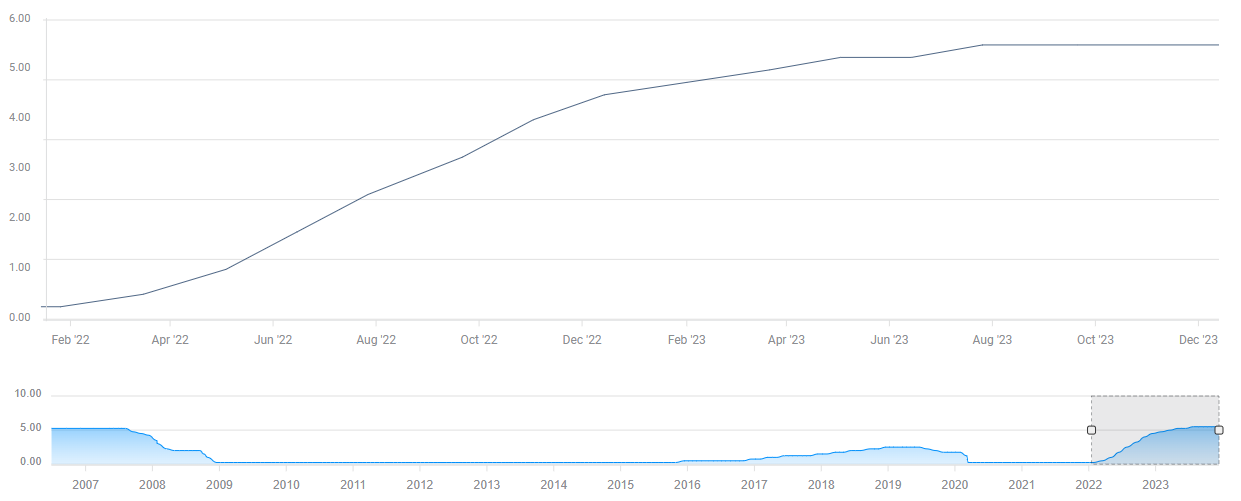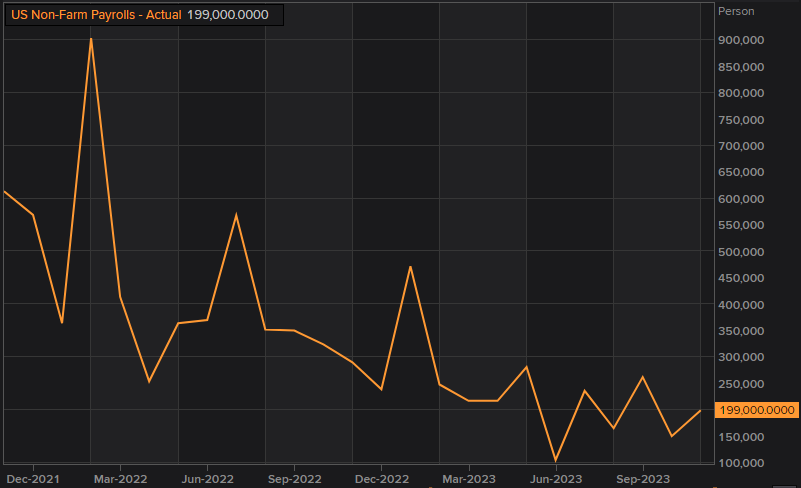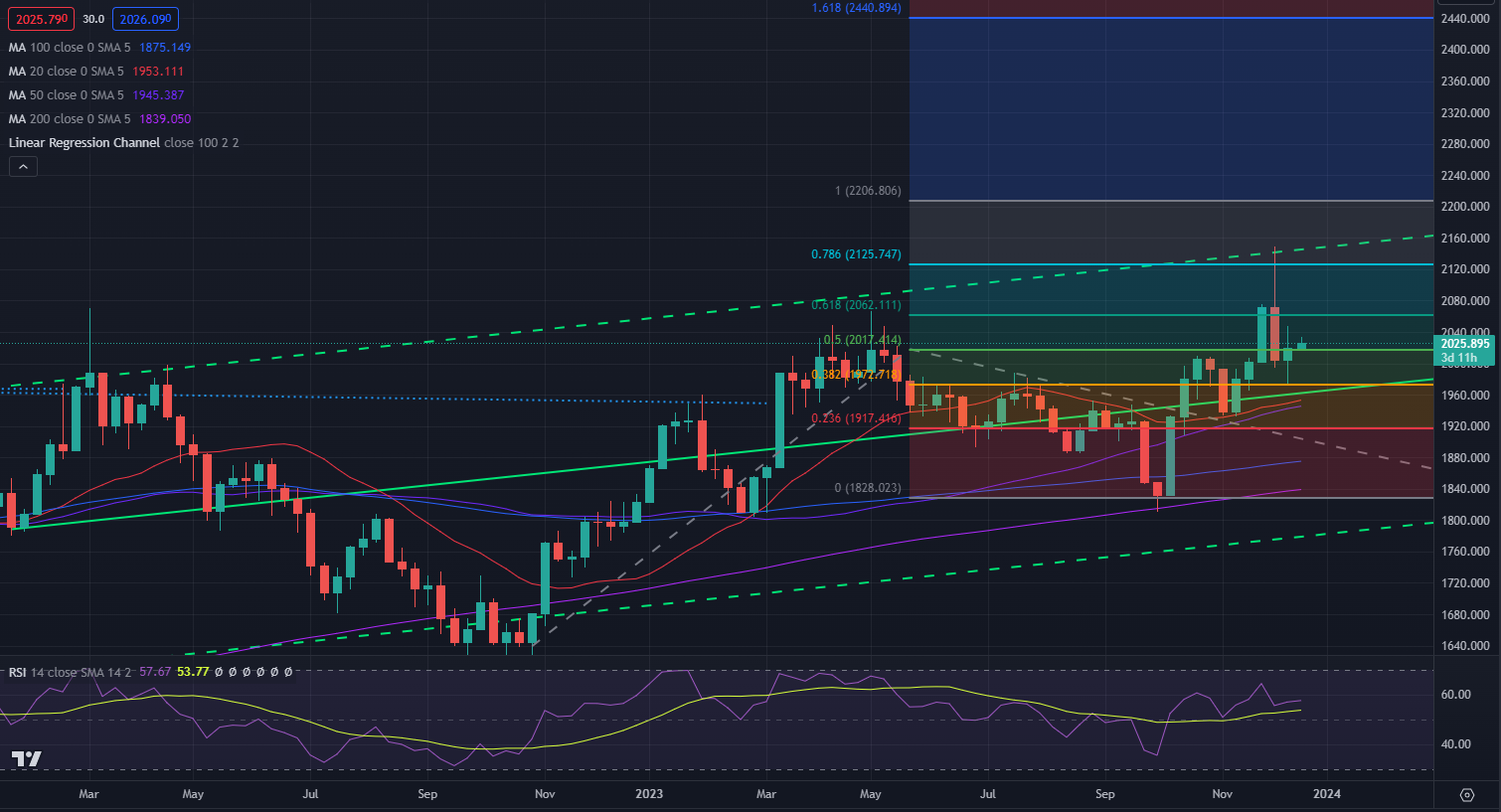- Gold set a new all-time high in 2023 and rose more than 10% on a yearly basis.
- The Fed policy and the state of the global economy are among major factors that could drive Gold prices.
- Technical outlook suggests that bullish potential remains intact heading into 2024.
Following the rally seen in the fourth quarter of 2022, Gold price continued to push higher to start 2023. After registering impressive gains in March, XAU/USD corrected lower in the third quarter before setting a new record high above $2,100 early December.
Gold faces a two-way risk heading into 2024. The Federal Reserve’s monetary policy decisions, the state of the global economy and geopolitical developments could significantly impact XAU/USD’s action in the new year.
Gold price in 2023: A year in review
US banking crisis and sticky inflation
Markets turned optimistic about the US Federal Reserve (Fed) taking its foot off of the tightening pedal toward the end of 2022. As the US Treasury bond yields turned south and continued to push lower to begin 2023, Gold preserved its bullish momentum and rose nearly 6% in January.
As the retreat in inflation slowed down in early 2023, Gold went into a consolidation phase, with markets re-assessing the Fed’s policy outlook. In March, however, the turmoil in the US banking sector provided a boost to XAU/USD and the pair climbed above $2,000 for the first time in a year. In a period of five days, three small-to-mid-size banks in the US – Silicon Valley Bank, Silvergate Bank and Signature Bank – failed, triggering a flight to safety. As the Fed and regulators quickly responded to ease the tension in financial markets by establishing the Bank Term Funding Program (BTFP), Gold retraced a portion of its monthly uptrend and posted small gains in April.
In the meantime, inflation in the US proved to be stickier than initially thought in the second quarter of the year, while the conditions in the labor market remained relatively tight. In response, the Fed continued to raise the policy rate. The US central bank opted for 25 basis points (bps) rate hikes in each of the first three meetings of the year, lifting the policy rate from 4.25%-4.5% to 5%-5.25%. Amid easing fears over the banking turmoil turning into a widespread crisis and rising US Treasury bond yields, Gold closed May and June in negative territory.
After a pause in June, the Fed hiked the policy rate again by 25 bps to 5.25%-5.5% in July. The Fed refrained from closing the door to further tightening as the US economy grew at a stronger pace than anticipated and the increase in Nonfarm Payrolls consistently beat expectations. Gold came under bearish pressure toward the end of summer and fell over 6% in a two-month period from August to the end of September.
Source: FXStreet Economic Calendar
Geopolitics and Fed’s dovish tilt
In the third quarter, growing signs of softening in the US labor market and easing price pressures allowed the Fed to refrain from tightening the policy further. Policymakers remained reluctant to hint at a policy pivot but Gold regained its traction. Concurrently, safe-haven flows started to dominate the financial markets after Israel declared a state of alert for war and began a counteroffensive operation in the Gaza Strip in response to Hamas launching a surprise attack on southern Israel on October 7, killing civilians and taking hostages. Gold shined as geopolitical tensions escalated and gained over 7% on a monthly basis.
Source: Reuters
As market participants grew increasingly convinced that the Fed had reached the end of its tightening cycle, Gold extended its uptrend in November. Once XAU/USD broke above $2,000, technical buyers also showed interest, helping the pair stretch higher.
News of Yemen's Houthi rebels hitting three commercial ships in the Red Sea on Sunday and a US warship responding by shooting down three drones on December 10 fueled a rally in Gold at the weekly opening. This development revived fears over the Israel-Hamas conflict turning into a widespread crisis in the Middle East and Gold reached an all-time high of $2,149 in the Asian trading hours of December 11. Although XAU/USD retreated sharply and declined below $2,000 in the following days, the dovish shift in the Fed’s tone in mid-December weighed on the USD and helped the pair find a foothold.
2024 Gold price outlook
State of the US economy, Fed pivot
Following the last policy meeting of the year, the Fed left the policy rate unchanged at 5.25%-5.5% and noted the steady improvement in the inflation outlook. In the post-meeting press conference, Chairman Jerome Powell said it would be premature to declare victory against inflation but acknowledged that the question of when it would be appropriate to start lowering rates was coming into view. “Policymakers are thinking, talking about when it will be appropriate to cut rates,” Powell said and added: “We are very focused on not making the mistake of keeping rates too high too long.”
At the time of writing, the CME Group FedWatch Tool showed that markets are pricing in a nearly 70% probability that the Fed will cut the interest rate by 25 bps in March. By December 2024, there is a nearly 60% chance that the Fed’s policy rate will be at 3.75%-4% or lower. The market positioning suggests that a relatively significant reduction in rates next year is already priced in, leaving room for a USD rally if macroeconomic data go against this expectation.
Source: CME Group
The Fed is also relatively confident that the US will avoid a recession. In the third quarter, the Gross Domestic Product (GDP) expanded at an impressive annual rate of 5.2%. Since inventory accumulation in that period was the primary driver behind the expansion, it will not be surprising to see a steep decline in the growth rate in the first half of 2024.
Three scenarios to consider for the first half of 2024
1. Inflation continues to decline steadily, while the labor market remains out of balance and the economic activity stays relatively healthy, with GDP growing between 1.5% and 2% in the first and the second quarters.
2. Inflation continues to decline steadily, while the unemployment rate rises noticeably and the US economy records concerning expansion rates of lower than 1% in the first and the second quarters.
3. Progress on inflation stops, with the Core Personal Consumption Expenditures Price Index rate stabilizing near 3%.
In the first scenario, Gold could stretch higher, but the upside is likely to remain capped before a new long-term uptrend is formed. A strong labor market, combined with a strong economy, should allow the Fed to adopt a cautious approach to the policy shift and limit the USD and bond yields’ declines.
The second scenario is also bullish for Gold, with the potential to record bigger gains than the first scenario. However, a weaker US economy could impact other economies, especially the Chinese economy, negatively and hurt the demand for Gold.
The third scenario is clearly bearish for Gold. The Fed’s priority is to bring inflation back to the 2% target and policymakers are likely to refrain from loosening the policy prematurely, even if the labor market or the economy doesn’t do well. In this case, a leg higher in the USD and bond yields could weigh on XAU/USD.
Uncertainties
Geopolitics: The Russia-Ukraine war in 2022 and the Israel-Hamas conflict in 2023 showed that Gold is still one of the preferred safe-haven assets in times of uncertainty. A further escalation and a spread of the conflict in the Middle East could lift Gold higher. In the meantime, a re-aggravation of the Russia-Ukraine war could have a similar impact on XAU/USD.
Presidential election in the US: It’s difficult to say how the outcome of the presidential election and all the related developments could influence the financial markets. However, there is a possibility, nearly 50% according to a Real Clear Politics poll conducted on December 15, that former President Donald Trump could be re-elected. If elected, Trump is looking to impose a 10% tariff on most foreign goods and phase out Chinese imports of essential goods in a four-year plan. Higher tariffs could make the Fed’s job of lowering inflation back to the 2% target more difficult while worsening relations with China could negatively impact Gold’s demand outlook.
Chinese economy: China is the biggest consumer of Gold in the world. Thanks to Covid reopening, the Chinese economy gathered growth momentum in 2023. Following an annual expansion of 6.3% in the second quarter, the GDP grew by 4.9% in the third quarter. On a negative note, recent PMI readings and data related to consumer activity showed signs of a slowdown. In an exclusive interview with Reuters, China’s government advisers said their growth targets for 2024 were between 4.5% and 5.5%. Meanwhile, rating agency Moody’s warned of a downgrade to China’s credit rating, lowering the ‘outlook’ to negative from ‘stable’ and citing "increased risks related to structurally and persistently lower medium-term economic growth and the ongoing downsizing of the property sector."
Gold technical outlook
The weekly chart confirms Gold’s bullish bias heading into 2024. The Relative Strength Index (RSI) holds comfortably above 50, where the RSI-based 20-period Moving Average is located. Additionally, XAU/USD remains within the upper half of the long-term ascending regression channel.
Gold faces interim resistance at $2,060, where the 61.8% Fibonacci trend-based extension aligns. Once that level is confirmed as support, XAU/USD could test $2,125-$2,150 area (78.6% Fibonacci trend-based retracement, all-time high, upper limit of the regression channel). In this scenario, buyers could look to book profits and make it difficult for Gold to extend its uptrend before making a technical correction. Nevertheless, in case the pair manages to stabilize above this resistance area, $2,200 and $2,440 could be set as next bullish targets, based on the Fibonacci trend-based extension. Given the slope of the ascending channel, however, it would likely take longer than several months for the pair to reach that final target and $2,200 area would have to stay intact as support for buyers to remain interested.
On the downside, the 20-week Simple Moving Average (SMA), the 50-week SMA and the mid-point of the ascending regression channel seem to have formed strong support at $1,960-$1,950. If that support fails, an extended decline toward $1,880 (100–week SMA) and $1,850 (200-week SMA) could be witnessed. A weekly close below the latter could bring in additional sellers and open the door for another leg lower toward $1,800 (lower limit of the ascending regression channel).
Summary
Gold carries its bullish potential into early 2024 on prospects of a looser Fed policy, lower US bond yields and a weaker USD. A downturn in the global economy, however, could weigh on demand and limit the precious metal’s gains. A lack of progress in the Fed’s efforts to lower inflation, on the other hand, could cause XAU/USD to turn south. The outcome of the 2024 Presidential election in the US, geopolitics and the state of the global economy are among the factors that could drive Gold’s valuation as well.
Gold FAQs
Why do people invest in Gold?
Gold has played a key role in human’s history as it has been widely used as a store of value and medium of exchange. Currently, apart from its shine and usage for jewelry, the precious metal is widely seen as a safe-haven asset, meaning that it is considered a good investment during turbulent times. Gold is also widely seen as a hedge against inflation and against depreciating currencies as it doesn’t rely on any specific issuer or government.
Who buys the most Gold?
Central banks are the biggest Gold holders. In their aim to support their currencies in turbulent times, central banks tend to diversify their reserves and buy Gold to improve the perceived strength of the economy and the currency. High Gold reserves can be a source of trust for a country’s solvency. Central banks added 1,136 tonnes of Gold worth around $70 billion to their reserves in 2022, according to data from the World Gold Council. This is the highest yearly purchase since records began. Central banks from emerging economies such as China, India and Turkey are quickly increasing their Gold reserves.
How is Gold correlated with other assets?
Gold has an inverse correlation with the US Dollar and US Treasuries, which are both major reserve and safe-haven assets. When the Dollar depreciates, Gold tends to rise, enabling investors and central banks to diversify their assets in turbulent times. Gold is also inversely correlated with risk assets. A rally in the stock market tends to weaken Gold price, while sell-offs in riskier markets tend to favor the precious metal.
What does the price of Gold depend on?
The price can move due to a wide range of factors. Geopolitical instability or fears of a deep recession can quickly make Gold price escalate due to its safe-haven status. As a yield-less asset, Gold tends to rise with lower interest rates, while higher cost of money usually weighs down on the yellow metal. Still, most moves depend on how the US Dollar (USD) behaves as the asset is priced in dollars (XAU/USD). A strong Dollar tends to keep the price of Gold controlled, whereas a weaker Dollar is likely to push Gold prices up.
Information on these pages contains forward-looking statements that involve risks and uncertainties. Markets and instruments profiled on this page are for informational purposes only and should not in any way come across as a recommendation to buy or sell in these assets. You should do your own thorough research before making any investment decisions. FXStreet does not in any way guarantee that this information is free from mistakes, errors, or material misstatements. It also does not guarantee that this information is of a timely nature. Investing in Open Markets involves a great deal of risk, including the loss of all or a portion of your investment, as well as emotional distress. All risks, losses and costs associated with investing, including total loss of principal, are your responsibility. The views and opinions expressed in this article are those of the authors and do not necessarily reflect the official policy or position of FXStreet nor its advertisers. The author will not be held responsible for information that is found at the end of links posted on this page.
If not otherwise explicitly mentioned in the body of the article, at the time of writing, the author has no position in any stock mentioned in this article and no business relationship with any company mentioned. The author has not received compensation for writing this article, other than from FXStreet.
FXStreet and the author do not provide personalized recommendations. The author makes no representations as to the accuracy, completeness, or suitability of this information. FXStreet and the author will not be liable for any errors, omissions or any losses, injuries or damages arising from this information and its display or use. Errors and omissions excepted.
The author and FXStreet are not registered investment advisors and nothing in this article is intended to be investment advice.
Recommended Content
Editors’ Picks

EUR/USD jumps back above 1.1000 on renewed US Dollar sell-off
EUR/USD is posting sizeable gains above 1.1000 in early Europe on Monday. EU prepares for retaliatory tariffs and rekindles the global trade war and US recession fears, drowning the US Dollar again aross the board. Traders now look to the EU Sentix and Retail Sales data.

GBP/USD holds recovery gains above 1.2900 amid fresh US Dollar weakness
GBP/USD clings to recovery gains above 1.2900 in European trading on Monday. The pair capitalizes on renewed US Dollar weakness as risk sentiment takes a fresh hit, with European traders hitting their desks. Trump's tariffs-led US recession fears and dovish Fed bets keep the USD undermined.

Gold price rebounds swiftly from multi-week low; lacks follow-through
Gold price reverses an Asian session slide to over a three-week low, though it lacks follow-through. Recession fears continue to weigh on investor sentiment and benefit the safe-haven commodity. Bets for more aggressive Fed rate cuts undermine USD and also lend support to the XAU/USD pair.

Crypto market wipes out $1 billion in liquidation as Asian markets bleed red
The crypto markets continue to decline on Monday, with Bitcoin falling below $78,000. The Asian markets also traded in the red, with Japan’s stock market extending losses to 8.5%, its lowest level since October 2023.

Strategic implications of “Liberation Day”
Liberation Day in the United States came with extremely protectionist and inward-looking tariff policy aimed at just about all U.S. trading partners. In this report, we outline some of the more strategic implications of Liberation Day and developments we will be paying close attention to going forward.

The Best brokers to trade EUR/USD
SPONSORED Discover the top brokers for trading EUR/USD in 2025. Our list features brokers with competitive spreads, fast execution, and powerful platforms. Whether you're a beginner or an expert, find the right partner to navigate the dynamic Forex market.



